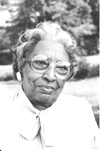
Mrs. Ira Cuffey
I have been living here since December 19, 1919. I grew up near Raynor Post Office, near Mt. Sinai Baptist Church. I was born in 1907. After we moved here, I went to school over in Riverview, for one year, and I drove to school with my mule and buggy, Old Roady.
********************
My schoolmates in the area were the Pretlows, Julie, Richard and Corine. Another family with children who lived near Sandy Mount were the Spratleys, Vera and Lucille, and they drove to school and used to park their horses back of the Delk Store. They had to walk over to Riverview.
My School days were out of town, but during school years everybody looked forward to exhibit day. All the schools all over the county would bring whatever the children had made—the little shuck baskets, pinecone baskets, embroidery and aprons—and then the schools were judged. I made a shuck basket and lined it with pink satin. You take the real thin parts of shucks and make it like a little cone. And you start at the bottom, and you go all the way around the top, and then you lined it. The foundation was a piece of cardboard. You made it in a circle or oblong, whatever you wanted. They weren’t for sale. They were just simply to show what you had done. The supervisor at that time, before Georgia Tyler, was Sarah Lafayette Jordan, and she would come by. She taught me how to do the chain stitch, the satin stitch and lazy daisy.
It was a big day, and they were selling ice cream, cookies, candy and everything. At that time, people were having parties and making sugar pudding. Some people call it stewed sugar. It’s just like taffy. That was a big day, boy. They exhibited. Everybody in town was there.
*******************
The public school in Riverview wasn’t large enough. It was real muddy on that hill. It was terrible. When the children would get to school, their feet and everything would be full of mud. Mr. Kenneth Pretlow, Mr. Frank Bowman and Mr. Clifton Hall and Mr. White from here around Zuni plus thirty-three other men pledged a hundred dollars each for a new school for Blacks. My father was one of the pledgees but he died before they got the money together. The land cost $3,300, and when they got the money together, they went to the School Board, and the School Board gave… deeded the land to the county, and the school was erected. All right, the school was there—I think we moved there in ’30—right now I’m confused—I don’t remember whether it was ’30 or’31, but it was in February, and I think the first principal was Ernest Finney. He had just finished Virginia State College, and Mr. Ray Branch was the first agricultural teacher—I think he was the first agricultural teacher.
I can’t remember now exactly whether they had four years at that time or eleven grades. You finished high school in eleventh grade. I don’t know whether Mrs. Virginia Little and Shirley Boothe—it was about seven or eight—that was some of the first graduates of Isle of Wight County Training School. So then, after Mr. Boothe finished college and Mrs. Edna Wrenn was teaching, we didn’t have no electric, (and by that time, World War II was on), so they gave the county all this electrical machinery to teach children in high school electrical welding. They went to the Board, and the Board said they didn’t have any money, and they couldn’t afford to give us the electricity. So Mr. Boothe, Mrs. Edna Wrenn and myself, we came back to the PTA and told them that we needed to raise the money, that we had been to the engineers to find out how much would it cost a pole to come up to the school. The county finally said they would see that the poles come up there, and the wires, but they wouldn’t buy the fixtures. So Mr. Boothe, Edna Wrenn and myself went to the School Board again. We told them we were trying to raise money enough to buy fixtures and have them connected. The superintendent was still Mr. Hall, so he said, “Well, if you all can do that, go ahead.” So, anyway, we raised the money through the PTA and went to Montgomery Ward, and we bought all the fixtures. Before we got them, the superintendent said, “Don’t pay for them. Give us the money and we’ll pay for them.” So the School Board paid for them, but we returned the money to the School Board. But they went on record as having paid for them.
The book Many Voices was published in 1986 as part of a project of the Interview Committee appointed in 1984 for the Isle of Wight County 350th Sesquitricentennial Celebration. The Oral History project taped the recollections of our older citizens and developed their stories from the transcriptions. Many Voices gave a permanent record of the previously unrecorded family life and history in Isle of Wight County. These excerpts take only the discussions dealing with the education memories of some of those citizens.